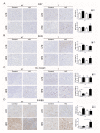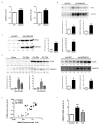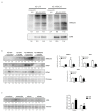ARMCX3 Mediates Susceptibility to Hepatic Tumorigenesis Promoted by Dietary Lipotoxicity
- PMID: 33807672
- PMCID: PMC7961652
- DOI: 10.3390/cancers13051110
ARMCX3 Mediates Susceptibility to Hepatic Tumorigenesis Promoted by Dietary Lipotoxicity
Abstract
ARMCX3 is encoded by a member of the Armcx gene family and is known to be involved in nervous system development and function. We found that ARMCX3 is markedly upregulated in mouse liver in response to high lipid availability, and that hepatic ARMCX3 is upregulated in patients with NAFLD and hepatocellular carcinoma (HCC). Mice were subjected to ARMCX3 invalidation (inducible ARMCX3 knockout) and then exposed to a high-fat diet and diethylnitrosamine-induced hepatocarcinogenesis. The effects of experimental ARMCX3 knockdown or overexpression in HCC cell lines were also analyzed. ARMCX3 invalidation protected mice against high-fat-diet-induced NAFLD and chemically induced hepatocarcinogenesis. ARMCX3 invalidation promoted apoptotic cell death and macrophage infiltration in livers of diethylnitrosamine-treated mice maintained on a high-fat diet. ARMCX3 downregulation reduced the viability, clonality and migration of HCC cell lines, whereas ARMCX3 overexpression caused the reciprocal effects. SOX9 was found to mediate the effects of ARMCX3 in hepatic cells, with the SOX9 interaction required for the effects of ARMCX3 on hepatic cell proliferation. In conclusion, ARMCX3 is identified as a novel molecular actor in liver physiopathology and carcinogenesis. ARMCX3 downregulation appears to protect against hepatocarcinogenesis, especially under conditions of high dietary lipid-mediated hepatic insult.
Keywords: Alex3; HCC; NAFLD; SOX9; lipotoxicity; obesity.
Conflict of interest statement
The authors declare no conflict of interest.
Figures









Similar articles
-
Function of Armcx3 and Armc10/SVH Genes in the Regulation of Progenitor Proliferation and Neural Differentiation in the Chicken Spinal Cord.Front Cell Neurosci. 2016 Mar 3;10:47. doi: 10.3389/fncel.2016.00047. eCollection 2016. Front Cell Neurosci. 2016. PMID: 26973462 Free PMC article.
-
High-saturate-fat diet delays initiation of diethylnitrosamine-induced hepatocellular carcinoma.BMC Gastroenterol. 2014 Nov 20;14:195. doi: 10.1186/s12876-014-0195-9. BMC Gastroenterol. 2014. PMID: 25410681 Free PMC article.
-
Compensatory upregulation of aldo-keto reductase 1B10 to protect hepatocytes against oxidative stress during hepatocarcinogenesis.Am J Cancer Res. 2019 Dec 1;9(12):2730-2748. eCollection 2019. Am J Cancer Res. 2019. PMID: 31911858 Free PMC article.
-
Hepatic leptin receptor expression can partially compensate for IL-6Rα deficiency in DEN-induced hepatocellular carcinoma.Mol Metab. 2018 Nov;17:122-133. doi: 10.1016/j.molmet.2018.08.010. Epub 2018 Sep 5. Mol Metab. 2018. PMID: 30224299 Free PMC article.
-
Diet-induced hepatic steatosis activates Ras to promote hepatocarcinogenesis via CPT1α.Cancer Lett. 2019 Feb 1;442:40-52. doi: 10.1016/j.canlet.2018.10.024. Epub 2018 Oct 26. Cancer Lett. 2019. PMID: 30401637
Cited by
-
MAFLD enhances clinical practice for liver disease in the Asia-Pacific region.Clin Mol Hepatol. 2022 Apr;28(2):150-163. doi: 10.3350/cmh.2021.0310. Epub 2021 Nov 10. Clin Mol Hepatol. 2022. PMID: 34753279 Free PMC article. Review.
-
Transcriptome Analysis of the Effects of X-Ray Radiotherapy on Non-small-cell Lung Cancer Using Next-generation Sequencing.In Vivo. 2025 Sep-Oct;39(5):2711-2727. doi: 10.21873/invivo.14070. In Vivo. 2025. PMID: 40877157 Free PMC article.
-
ARMCX3 regulates ROS signaling, affects neural differentiation and inflammatory microenvironment in dental pulp stem cells.Heliyon. 2024 Aug 28;10(17):e37079. doi: 10.1016/j.heliyon.2024.e37079. eCollection 2024 Sep 15. Heliyon. 2024. PMID: 39296219 Free PMC article.
-
Screening of crosstalk and pyroptosis-related genes linking periodontitis and osteoporosis based on bioinformatics and machine learning.Front Immunol. 2022 Aug 5;13:955441. doi: 10.3389/fimmu.2022.955441. eCollection 2022. Front Immunol. 2022. PMID: 35990678 Free PMC article.
-
Prognostic value and immune infiltration of ARMC10 in pancreatic adenocarcinoma via integrated bioinformatics analyses.Heliyon. 2023 Sep 27;9(10):e20464. doi: 10.1016/j.heliyon.2023.e20464. eCollection 2023 Oct. Heliyon. 2023. PMID: 37842592 Free PMC article.
References
-
- Lopez-Domenech G., Serrat R., Mirra S., D’Aniello S., Somorjai I., Abad A., Vitureira N., García-Arumí E., Alonso M.T., Rodriguez-Prados M., et al. The Eutherian Armcx genes regulate mitochondrial trafficking in neurons and interact with Miro and Trak2. Nat. Commun. 2012;3:814. doi: 10.1038/ncomms1829. - DOI - PubMed
-
- Serrat R., Lopez-Domenech G., Mirra S., Quevedo M., Garcia-Fernandez J., Burgaya F., Soriano E. The non-canonical Wnt/PKC pathway regulates mitochondrial dynamics through degradation of the arm-like domain-containing protein ARMCX3. PLoS ONE. 2013;8:e67773. doi: 10.1371/journal.pone.0067773. - DOI - PMC - PubMed
Grants and funding
LinkOut - more resources
Full Text Sources
Other Literature Sources
Molecular Biology Databases
Research Materials

